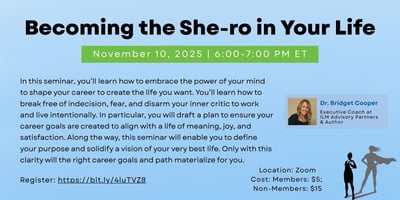We often wait for change to come from outside us- a new job, a better boss, a clearer  path. What if the transformation we seek starts not with external shifts, but with internal agreements we’ve unknowingly made with ourselves?
path. What if the transformation we seek starts not with external shifts, but with internal agreements we’ve unknowingly made with ourselves?
In her upcoming WEST workshop, “Becoming the She-ro in Your Life,” Dr. Bridget Cooper invites us to examine the subtle “contracts” that shape our choices, beliefs, and sense of control. These internal agreements, often formed in childhood or reinforced through life experience, become the invisible operating system that drives our thoughts and behaviors. Without realizing it, we may agree to things like “I have to please others to be valued” or “I’m not ready to lead.”
The roadblock to our success isn’t the world around us, it’s the outdated software running within us.
The Science of Self-Rewiring
Neuroscience offers encouraging news: we can change our minds. Each thought and belief we challenge literally reshapes the brain’s neural connections through a process called neuroplasticity (Draganski et al., 2004; Pascual-Leone et al., 2005). Myelin, the fatty sheath that strengthens neural pathways, develops most rapidly in early childhood and adolescence, but research shows it continues to respond to focused practice and learning well into adulthood (Fields, 2015).
In other words, when we question the “contracts” that no longer serve us and intentionally replace them with new beliefs, we’re not just thinking differently, we’re rewiring the architecture of our own minds.
From Limiting Beliefs to Liberating Purpose
Dr. Cooper challenges participants to ask: “Is this belief fact or fiction?” and “What am I agreeing to in my life that I can no longer choose to uphold?” This kind of inquiry activates the prefrontal cortex, the brain’s center for conscious decision-making, helping us override reactive patterns driven by the amygdala, the seat of fear and habit (Davidson & McEwen, 2012).
But shifting belief alone isn’t enough. As Dr. Cooper explains, “It’s not about what you do, it’s about why you do it.” Purpose isn’t just a lofty ideal; it’s a neurobiological need. Studies have shown that having a clear sense of purpose improves motivation, resilience, and even physical health, influencing longevity and well-being (Hill & Turiano, 2014).
Defining your purpose is what transforms your career from a checklist of tasks into a channel for self-expression, much like Jane Goodall’s work became an extension of who she is, not just what she does.
Guided by Core Words, Fueled by Passion
Dr. Cooper uses three words to describe her calling: Guide. Inspire. Connect. These core words reflect the place in her life where her energy is optimized, a state psychologists call flow, where challenge meets natural skill and passion (Csikszentmihalyi, 1990). When we operate from this space, work stops being a grind and starts becoming an authentic expression of self.
Participants in Becoming the She-ro in Your Life will have the opportunity to uncover their own core words, the ones that clarify who they are at their best and help them make decisions aligned with that truth. With this awareness, you can start creating time for what nourishes you and release what doesn’t.
It’s not about becoming someone new; it’s about remembering who you were before fear, doubt, and expectation took the reins.
Ready to Step Into Your Story?
Your “She-ro” doesn’t wait to be rescued, she rescues herself, by reclaiming authorship of her own life. If you’re ready to awaken to your own power, challenge limiting beliefs, and design a career that reflects your purpose and joy, join Dr. Bridget Cooper and WEST for this transformative event.
Because the most powerful story you’ll ever tell, is the one you live.
References
- Csikszentmihalyi, M. (1990). Flow: The Psychology of Optimal Experience. Harper & Row.
- Davidson, R. J., & McEwen, B. S. (2012). Social influences on neuroplasticity: Stress and interventions to promote well-being. Nature Neuroscience, 15(5), 689–695.
- Draganski, B., et al. (2004). Changes in grey matter induced by training. Nature, 427(6972), 311–312.
- Fields, R. D. (2015). A new mechanism of nervous system plasticity: activity-dependent myelination. Nature Reviews Neuroscience, 16(12), 756–767.
- Hill, P. L., & Turiano, N. A. (2014). Purpose in life as a predictor of mortality across adulthood. Psychological Science, 25(7), 1482–1486.
Pascual-Leone, A., et al. (2005). The plastic human brain cortex. Annual Review of Neuroscience, 28, 377–401.
